Life of Christ in art
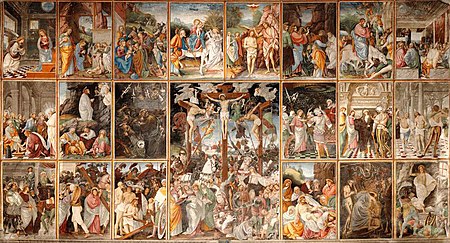
The life of Christ as a narrative cycle in Christian art comprises a number of different subjects showing events from the life of Jesus on Earth. They are distinguished from the many other subjects in art showing the eternal life of Christ, such as Christ in Majesty, and also many types of portrait or devotional subjects without a narrative element.

They are often grouped in series or cycles of works in a variety of media, from book illustrations to large cycles of wall paintings, and most of the subjects forming the narrative cycles have also been the subjects of individual works, though with greatly varying frequency. By around 1000, the choice of scenes for the remainder of the Middle Ages became largely settled in the Western and Eastern churches, and was mainly based on the major feasts celebrated in the church calendars.
The most common subjects were grouped around the birth and childhood of Jesus, and the
Most common scenes

The main scenes found in art during the Middle Ages are:[2]
Birth and childhood sequence
These scenes also could form part of cycles of the Life of the Virgin:
- Annunciation to Mary, showing the conception of Jesus
- Nativity of Jesus in art
- Adoration of the Magi (Three Kings), sometimes combined with the Adoration of the Shepherds
- Circumcision of Christ
- Presentation of Jesus
- Flight to Egypt, or the Massacre of the Innocents. Later sometimes the Rest on the Flight into Egypt.
- Canonical Gospels.
Mission period
- Baptism of Jesus
- Miraculous catch of fish, more often found in Lives of apostles.
- Temptation of Christ, often divided into its three parts.
- Wedding at Cana, the first miracle recorded in the Gospels, and the only one at which Mary was present.
- The Samaritan woman at the well is occasionally depicted
- Transfiguration of Jesus, much more common in the Eastern than Western church
- Raising of Lazarus
- Jesus at the home of Martha and Mary, sometimes seen from the Counter-Reformation onwards.
Passion of Christ

- Christ taking leave of his Mother, a late medieval development, not based on any Gospel episode.
- Palm Sunday, Christ's entry into Jerusalem
- Jesus and the money changers, much more popular as a single subject from the Renaissance on
- Washing of feet
- Agony in the Garden of Gethsemane
- Betrayal of Christ and Arrest of Jesus
- Denial of Peter – if included, usually the only Passion scene not to include Christ
- Sanhedrin Trial of Jesus
- Christ before Pilate
- Flagellation of Christ
- The Crowning with Thorns
- Mocking of Jesus
- Pensive Christ
- Ecce homo
- Christ carrying the Cross
- Veil of Veronica (Holy Face)
- Crucifixion in the arts, including:
- Descent from the Cross (Deposition of Christ)
- Lamentation of Christ and Pietà
- Epitaphios, or "Anointing of Christ"
- Entombment of Christ
- Harrowing of Hell, not in the Gospels
- Man of Sorrows
Resurrection to Ascension
- Three Marys or Myrrhbearersfinding an empty tomb was shown, or the next three scenes.
- Noli me tangere
- Meeting or Supper at Emmaus
- Doubting Thomas
- Ascension of Jesus in Christian art
Byzantine set of 12 scenes
In
Choice of scenes
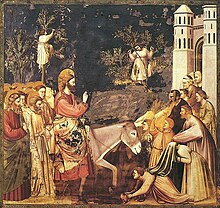
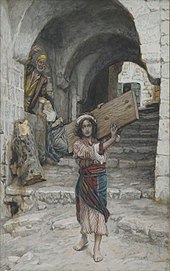
After the Early Christian period, the selection of scenes to illustrate was led by the occasions celebrated as Feasts of the Church, and those mentioned in the Nicene Creed, both of which were given prominence by the devotional writers on whose works many cycles appear to be based. Of these, the Vita Christi ("Life of Christ") by Ludolph of Saxony and the Meditations on the Life of Christ were two of the most popular from the 14th century onwards. Another influence, especially in smaller churches, was liturgical drama, and no doubt also those scenes which lent themselves to a readily identifiable image tended to be preferred. Devotional practices such as the Stations of the Cross also influenced selection.
The
However, some miracles commonly used as paradigms for Christian doctrines continued to be represented, especially the Wedding at Cana and Raising of Lazarus, which were both easy to recognise as images, with Lazarus normally shown tightly wrapped in a white shroud, but standing up. Paintings in hospitals were more likely to show scenes of the miraculous cures. An exception is
The scenes originating in the apocryphal Gospels that remain a feature of the depiction of Life of the Virgin have fewer equivalents in the Life of Christ, although some minor details, like the boys climbing trees in the Entry to Jerusalem, are tolerated. The Harrowing of Hell was not an episode witnessed or mentioned by any of the Four Evangelists but was approved by the Church, and the Lamentation of Christ, though not specifically described in the Gospels, was thought to be implied by the accounts there of the episodes before and after. Vernacular art was less policed by the clergy, and works such as some medieval tiles from Tring can show fanciful apocryphal legends that either hardly ever appeared in church art, or were destroyed at some later date.[7]
By the
Cycles
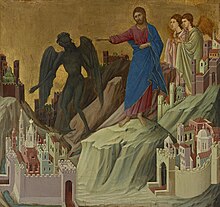
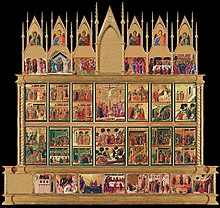
The only
For the rest of the Early Medieval period illuminated manuscripts contain the only painted scenes to have survived in quantity, though many scenes have survived from the applied arts, especially ivories, and some in cast bronze. The period of Christ's Works still seems relatively prominent compared to the High Middle Ages.[11]
Although this was the period when the
In painting, the Life was often shown on one side of a church, paired with
From the 15th century
In Protestant areas production of paintings of the Life stopped very soon after the
Parables
Of the thirty or so
From the Renaissance the numbers shown widened slightly, and the three main scenes of the Prodigal Son – the high living, herding the pigs, and the return – became the clear favourites.
Individual cycles with articles

- St. Augustine Gospels, Italian, about 600, now only a quarter survives. Many miracles.
- Castelseprio
- Codex Aureus of Echternach, 11th-century Ottonian gospel book, with some 60 scenes, including many parables
- St. Albans Psalter, cycle of 40 images, mostly full-page. The Nativity story has 7 scenes, and from the Annunciation to the Return from Egypt takes 13.
- Eadwine Psalter, English manuscript of the mid-12th century, the prefatory cycle now dispersed
- Scrovegni Chapel by Giotto, a large combined Life of Christ and of the Virgin in fresco with nearly forty narrative scenes.
- Life of Christ (Giotto), a series of small panel paintings attributed to Giotto
- Life of Christ (circle of Cimabue?), a series of small panel paintings speculatively attributed to the circle of Cimabue
- Maestà (Duccio), a large combined Life of Christ and of the Virgin with nearly fifty scenes in total, on both sides of a panel altarpiece.
- Vyšší Brod (Hohenfurth) cycle, 9 panels, Bohemian Gothic
- Walls of the Perugino
- Raphael Cartoons tapestry designs for the Sistine Chapel, a cycle of the lives of saints Peter and Paul, with some scenes from the Life of Christ (see also the Brancacci Chapel by Masaccio)
See also
- Chronology of Jesus
- Depiction of Jesus
- Life of Christ Museum
- List of New Testament stories
- List of statues of Jesus
Notes
- ^ Schiller, I, 152
- ^ Schiller has sections on each of these, and many other less common subjects. Mâle's Chapter 2 analyses 13th-century French Cathedral scenes in the text, and an appendix listing the contents of many.
- ISBN 0719539714
- ^ Schiller, I, 152–3
- ^ Lewine, Carol F.; JSTOR Vulpes Fossa Habent or the Miracle of the Bent Woman in the Gospels of St. Augustine, Corpus Christi College, Cambridge,
- ISBN 0-226-14292-2
- ^ Tring tile, Victoria & Albert Museum]
- ^ Mâle, 177
- ^ Schiller, II, 26–7
- Istanbul Archaeological Museum, Inv. no 82.
- ^ Schiller, I, 154
- ^ Dick Stracke. "Miracles, Augusta State University". Aug.edu. Archived from the original on 2012-02-12. Retrieved 2012-06-05.
- ^ "Vatican Museums". Mv.vatican.va. Retrieved 2012-06-05.
- ^ Kurth, Willi. The Complete Woodcuts of Albrecht Durer, Dover Books, New York, 1963. All images at Harvard external link.
- ^ Strauss, Walter L. The Complete Engravings, Etchings and Drypoints of Albrecht Durer, Dover Books, New York, 1972
- ^ Mâle, 195
- ^ Gerard van Honthorst
- ^ Return of the Prodigal Son
References
- G Schiller, Iconography of Christian Art, Vol. I,1971 (English trans from German), Lund Humphries, London, p. 56 & figs, ISBN 0-85331-270-2
- G Schiller, Iconography of Christian Art, Vol. II,1972 (English trans from German), Lund Humphries, London, figs 471–75, ISBN 0-85331-324-5
- ISBN 978-0064300322
External links
- The Romanesque cycle in the St Albans Psalter
- The Passion Cycle in the English Parish Church
- Thesis on the cycle in the Avila Bible by Monica Ann Walker-Vadillo File size 6.5MB
- Dürer's three print Passion cycles from Harvard Art Museum
- Christian Iconography from Augusta State University – see under Jesus Christ, after alphabet of saints
